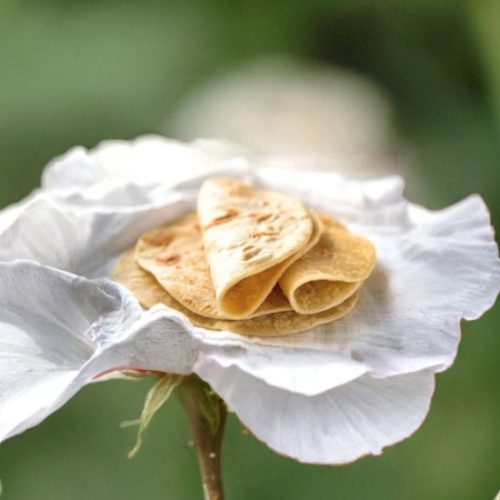All products are selected by our editorial team for quality. If you buy through our links, we may earn a small commission at no extra cost to you.
This Easy Soft Flatbread recipe stands out for its incredible simplicity and versatility.
Without the need for yeast, it’s perfect for those looking for a quick homemade bread alternative that still delivers on softness and pliability.
The dough requires minimal kneading and a brief resting time, making it an accessible choice for everyday cooking or last-minute meals.
Nutritionally, this flatbread offers a decent amount of protein (8g per serving) and moderate fat from the butter, balancing indulgence and nourishment.
Its moderate carbohydrate content makes it a satisfying base for wraps or sides in Mediterranean and Greek dishes.
The ability to customize with dairy-free or gluten-free alternatives adds to its appeal for various dietary needs.
Whether you’re preparing a quick gyro, dipping bread for curries, or crafting a fresh wrap, this recipe’s ease and adaptability make it a pantry staple that supports quick meal prep and delicious homemade convenience.
Must-Have Tools for Perfect Results
Non-Stick Skillet
Essential for cooking flatbreads evenly without sticking or burning. Its smooth surface ensures the bread puffs up nicely and develops those signature golden brown spots, while also being easy to clean. A versatile pan for sautéing, frying, and more.
Rolling Pin
Perfect for rolling the dough into uniform 20cm rounds with consistent thickness. It helps achieve that ideal balance between thin and soft flatbreads. A kitchen must-have for baking, pastry making, and dough preparation.
Mixing Bowl
A sturdy mixing bowl provides the ideal space to combine and knead the dough comfortably. Look for one that’s large enough to allow easy mixing without mess. Useful for any baking or cooking prep tasks.
Measuring Cups and Spoons
Accurate measurements ensure your dough consistency every time. Precise flour and liquid amounts are key to achieving the right texture and softness. These tools are essential for both baking and cooking precision.
Clean Kitchen Towel
Wrapping cooked flatbreads in a towel traps moisture, keeping them soft and pliable. It’s a simple trick that improves texture and flavor, especially useful for warming or resting breads and tortillas.

Flatbread
Equipment
- 1 Non-stick skillet (10-12 inch)
- 1 Rolling Pin
- 1 large mixing bowl
- Measuring cups and spoons set
- Clean kitchen towel
Ingredients
- 2 cups all-purpose flour plus extra for dusting
- ½ teaspoon salt
- 3 ½ tablespoons unsalted butter about 50g
- ¾ cup whole milk
Instructions
- Warm Butter and Milk: Gently heat the milk and butter together in a small saucepan or microwave until the butter is just melted. The mixture should be warm but not hot to the touch.
- Combine Dry Ingredients: In a large mixing bowl, whisk together the flour and salt to evenly distribute the seasoning.
- Form the Dough: Pour the warm butter and milk mixture into the flour mixture. Stir with a spoon or spatula until the dough begins to come together into a shaggy mass.
- Knead Until Smooth: Lightly flour your work surface and transfer the dough onto it. Knead the dough gently for about 2 minutes, just until it becomes smooth and pliable. If it feels too sticky, sprinkle a little more flour, but be careful not to add too much.
- Let Dough Rest: Wrap the dough tightly in plastic wrap or cover it with a clean cloth. Leave it to rest at room temperature for approximately 30 minutes. This resting period helps relax the gluten, making the dough easier to roll out.
- Divide and Roll Out: Once rested, divide the dough into six equal pieces. Roll each piece into a ball, then flatten and roll out into thin circles roughly 20cm (8 inches) in diameter and 2-3 millimeters thick. Lightly dust your surface and rolling pin to prevent sticking.
- Cook the Flatbreads: Heat a dry non-stick skillet over high heat. Place one dough round in the hot pan and cook for about 1 to 1½ minutes. You’ll notice the bread puff up and develop golden brown spots on the bottom. Flip and cook the other side for another 45 seconds to 1 minute until golden spots appear and it puffs again.
- Keep Warm and Soft: As you finish cooking each flatbread, stack them on a plate and cover with a clean kitchen towel. The trapped steam keeps them soft and pliable, perfect for wrapping or stuffing.
- Optional Finishing Touch: For extra flavor and richness, lightly brush the warm flatbreads with melted butter or olive oil. You can also mix minced garlic into the butter for a delicious garlic-flavored finish.
Notes
- Heat and Thickness Adjustments: Cooking at higher heat and rolling the dough thinner results in a crispier crust, similar to naan, but thinner crusts may crack when rolling.
- Storage Tips: The dough can be refrigerated for up to 3 days. For convenience, roll out the dough portions before refrigerating and separate them with parchment or plastic wrap to prevent sticking. Cooked flatbreads freeze well and can be reheated in a skillet or microwave.
- Flour Substitutions: Whole wheat flour works well for a heartier texture. Almond flour is not recommended.
- Dairy-Free and Vegan Options: Replace butter with olive oil or coconut oil, and substitute cow’s milk with almond or other plant-based milk. The recipe adapts well to these swaps without losing texture.
- Gluten-Free Version: Using gluten-free flour is possible, but you may need to add extra flour when rolling out. The texture will be slightly chewier, and the rounds may not be perfectly smooth.
- Serving Suggestions: Ideal for wraps like gyros, souvlaki, or as a flatbread side for curries such as butter chicken, chickpea curry, or beef rendang.
Chef’s Secrets for Flawless Flatbread
Achieving soft, pliable flatbread every time starts with proper dough handling and temperature control.
Use warm milk and melted butter to create a tender dough that’s easy to work with but not too sticky.
Knead gently—overworking can toughen the bread—just enough to bring everything together smoothly.
Allowing the dough to rest at room temperature is crucial as it relaxes the gluten, making rolling easier and the final bread softer.
When cooking, a hot, dry non-stick pan helps create those characteristic golden spots and puffs, mimicking traditional flatbreads like naan.
To keep your breads soft after cooking, stack them covered with a clean kitchen towel—this traps steam and preserves moisture.
For an indulgent twist, brushing with garlic-infused butter adds a delicious flavor boost.
Lastly, don’t be afraid to experiment with flour types or dairy-free substitutes; this recipe is forgiving and adaptable.
Serving Suggestions That Elevate Any Meal
This soft flatbread is a wonderfully versatile base for countless dishes.
Use it to wrap flavorful fillings such as grilled chicken, roasted vegetables, or falafel for quick Mediterranean-style wraps.
It also pairs beautifully with rich, saucy curries like butter chicken or chickpea curry, perfect for scooping up every last bite.
For a simple yet satisfying snack, spread with hummus, labneh, or tzatziki, then sprinkle with fresh herbs.
You can even transform these flatbreads into mini pizzas or grilled sandwiches.
Serving them warm enhances their softness and taste, so consider reheating gently before plating.
Whether for casual lunches, family dinners, or meal prepping for the week, these flatbreads bring both texture and flavor to your table.
Smart Storage Tips to Keep Flatbread Fresh
Proper storage ensures your homemade flatbreads stay soft and ready to use whenever you need them.
If you plan to use the dough within three days, keep it wrapped tightly in plastic wrap or stored in an airtight container in the refrigerator.
For convenience, pre-roll the dough pieces with parchment paper separating them to prevent sticking.
Cooked flatbreads freeze wonderfully; simply cool them completely, stack with parchment paper between each piece, and place them in a freezer-safe bag.
To thaw, warm them gently in a dry pan or microwave wrapped in a damp paper towel to revive softness.
Avoid refrigerating cooked flatbreads uncovered, as they tend to dry out quickly.
These simple steps help maintain their texture and flavor, making your meal prep smooth and hassle-free.
Frequently Asked Questions About Flatbread
Q1: Can I use whole wheat flour instead of all-purpose?
Absolutely! Whole wheat flour works well and gives a nuttier flavor and heartier texture. You may need to add a little extra water or milk as whole wheat flour absorbs more liquid.
Q2: Is it possible to make this recipe vegan?
Yes, simply substitute the butter with olive oil or coconut oil, and replace dairy milk with almond, soy, or any other plant-based milk. The dough remains soft and flavorful.
Q3: How thin should I roll the dough?
Aim for about 2 to 3 millimeters thickness. Thinner dough cooks faster and gets crispier edges, while thicker dough stays softer but may take a bit longer to cook through.
Q4: Why didn’t my flatbreads puff up during cooking?
Puffing happens when steam builds inside the dough. Make sure your pan is very hot and you rolled the dough evenly. If the pan isn’t hot enough or the dough is too thick, it may not puff.
Q5: How long can I store the dough and cooked flatbreads?
The dough keeps well in the fridge for up to 3 days when wrapped properly. Cooked flatbreads can be stored in the freezer for up to 2 months, making them perfect for meal prep.
This recipe is inspired by recipetineats and has been carefully refined to enhance clarity, streamline preparation steps, and ensure accurate results. We’ve also included health benefits, nutritional highlights, and Must-Have Tools to help you get the best results every time you cook.


